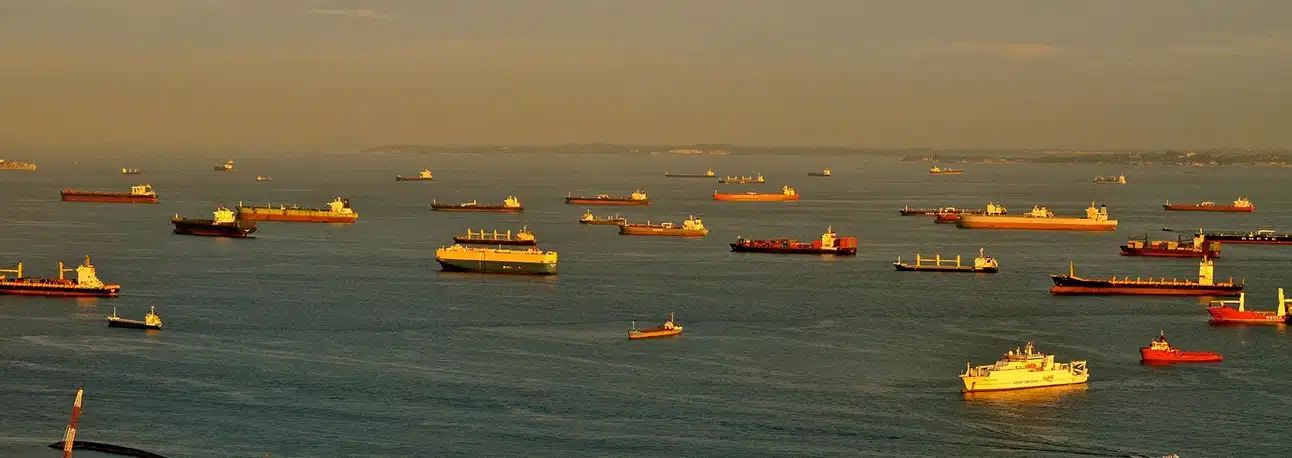By Chris Insall, Head of Maritime Market Development, ST Engineering iDirect
Ranked as the top maritime capital of the world since 2015, the Port of Singapore is the world’s busiest transshipment port. Due to its strategic location on the Malacca Straits, Singapore has been a main trading post for the last two centuries and today it continues to grow in importance. The Singapore Maritime Authority has big plans for the port and the Prime Minister, Lee Hsien Loong, has promised that it will be the world’s largest fully automated port by the year 2040.
A mixture of vessels use the port on a daily basis, from container ships (28%), pleasure craft (20%), oil/chemical tankers (11%), oil products tankers (6%) and crude oil tankers (4%) [Source: maritimetraffic.com]. The port currently transships a fifth of the world’s containers and half the world’s supply of crude oil.
Given this incredibly busy location and the variety of vessels that frequent it day in and day out, the use of satellite communications is becoming increasingly important. The digitalization of the maritime sector is in full swing and has taken on significant momentum over the past few years. However, in such a densely populated shipping area this demands reliable connectivity to ensure that operations can become more efficient and fulfill critical functions.
Connecting the crew
The global pandemic highlighted the essential nature of high-quality crew connectivity to support life at sea. During this period, many crew were stranded throughout the Straits with very limited access to vital communications. Today, it is considered an essential service for any company that employs crew on board their vessels. The crew demographic is undergoing change. No longer is recruiting crew a matter of finding the cheapest labor. The budding crew members of today are digital natives, equipped with multiple devices and high expectations of a living-room-like connectivity experience. When looking for employment, the availability of reliable and powerful communications often forms the basis of their decision.
The challenge for service providers lies in the ability to offer flexible technology that maximizes value
yet minimizes the total cost of ownership. This is achieved through effective management of bandwidth to allocate available resources where they are needed whilst offering an excellent user experience that can cope with the demand of applications utilized by crew to chat with friends and family online, make and receive video calls, surf the internet and stream video, as well as the operational applications that are used daily.
Alarming increase in piracy
The Malacca and Singapore Straits are a magnet for pirates. 2023 has seen a significant rise in incidents of piracy due to rising traffic passing through the waters. According to ReCAAP ISC, since the beginning of 2023, in the Straits of Malacca and Singapore, 41 incidents were reported between January and June in comparison with 27 incidents during the same period in 2022. Unfortunately, this trend appears to be worsening and, with incidents involving violent attacks, crews are finding themselves exposed to increased risk.

With challenges like piracy, crew welfare and operational efficiencies at top of mind for vessel operators of all kinds, the quality of service, or QoS, of the satellite connectivity is integral to their communications and cannot be left uncertain. However, to achieve this, there are many different facets that come together to make a complete satellite offering that can be relied upon at sea. This necessitates a new, multi-layered approach.
Layering up on QoS
Vessel operators of all kinds expect an SLA (Service Level Agreement) which ensures data connectivity containing a degree of CIR (Committed Information Rate) that guarantees an optimum level of availability, usually 99 or 99.5%. This defines the proportion of time that the CIR is available. There are other factors to consider such as jitter and round-trip delay. There can be many ships in any region at any one time, and each ship will have different bandwidth demands, but the operators need to ensure that bandwidth is made consistently available to all contracted ships. With so many mission-critical communications converging onboard a vessel, patchy service is unacceptable. Users are also looking for symmetrical service for applications such as videoconferencing and social media uploads. The requirement for fully two-way communications is a growing trend.
There are multiple elements that come together to create the satcom advanced mobility toolkit that service providers need to offer the very highest quality, reliable connectivity that fleet operators need.
At ST Engineering iDirect, we have been developing our advanced mobility portfolio for decades. Our long heritage and experience in the maritime sector, as well as our proven technology, has been forged over decades. We understand the requirements that merchant shipping has, including critical aspects such as the need for symmetrical communications. Global Bandwidth Management is a critical consideration as it offers the tools to orchestrate the bandwidth and deliver high QoS over multiple beams, networks and constellations. We understand that QoS is king and that the smooth operation of shipping fleets depends on it.
An advanced approach
Let’s take a deeper dive into the different facets of our advanced mobility innovations and how they provide for merchant fleets today and into the future.
Over the years, we have pioneered various waveforms to address a variety of use cases. Our Mx-DMA MRC waveform combines the scalability of TDMA returns with the efficiency and throughputs of SCPC that mobility networks require. Mx-DMA MRC supports high speed returns of up to 300 Mbps with symbol rates up to 100 Msps on the MDM5010, the industry’s fastest VSAT modem for shared bandwidth networks.
The MDM3315 is our newest mid-range modem for maritime applications. It’s supported on all iDirect VSAT platforms with multiple return technologies to choose from, depending on the platform. Both the MDM5010 and MDM3315 is also engineered for our next-generation platform. Users are choosing a protected, flexible investment with a solid pathway into the future.

Beam switching is a key aspect that many claim to offer, but the devil is in the details. Mobility terminals are constantly switching beams and sometimes satellites. The amount of time it takes to switch beams is critical to the overall service offering. Our advanced mobility technology enables very fast beam acquisition so the timeframe to re-acquire into the network and to switch beams is optimized. It also maintains link robustness and dynamically maximizes transmission throughput while avoiding the creation of interference on other carriers and modems.
We’re also now seeing networks that have heterogeneous user requirements with a mix of ships, which results in a wide variation of terminal types and throughput requirements per terminal. The ability to be able to manage different types of throughput and antenna performance requirements and based on seasonal and throughput volume within a single network is a key differentiator for service providers. Our advanced mobility solution has been adopted by satellite operators and service providers to provide satellite connectivity to a wide range of fleet operators that range from merchant shipping to cruise vessels.
GEO, MEO, LEO and 5G future
The beginnings of software-defined networks will enable service providers with flexible capabilities to deliver coverage and capacity anywhere and in real time. Such dynamic configuration is a brand-new requirement for the market, that we as a ground technology provider must effectively support. Ground technology will offer the counterpart to space resources through cloud-based, virtualized networks. These will increase the network’s ability to deploy new networks or upgrade to new technology quickly, connect to other hybrid technologies, create flexible, scalable virtual architectures, and dynamically orchestrate networks and capacity across multi-orbit constellations.
As with other market segments, there is keen interest in upcoming NGSO constellations, but also on enhanced terrestrial connectivity. The telco world has moved towards the 5G mobile standard, which offers a universal architecture integrating every form of access technology into one common network. The maritime sector is also adopting critical IT advances like standardization, virtualization, and orchestration to improve the speed, scale, cost, and flexibility of service delivery. This will facilitate a multitude of use cases on board merchant ships that require careful management of the ship’s main engines, propulsion systems, power generation and distribution, cooling systems, control systems and all other mechanical systems on board as well as the navigation of the vessel using the latest technology and cargo operations while maintaining the safety and security of the ship, its cargo and crew.
The satellite industry must adopt these standards to better integrate with these networks to deliver consistent quality of services across multiple access networks and orbits.
Bottom line
VSAT-based connectivity remains the most reliable and consistent means of delivery of satellite services for communications providers. In a sector where QoS is integral, a suite of advanced mobility capabilities is essential for any operator as they navigate their way through crowded and challenging waters such as the Malacca Straits.
Find out more about our advanced mobility offering for merchant shipping here.
